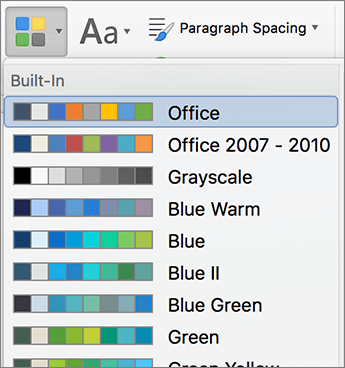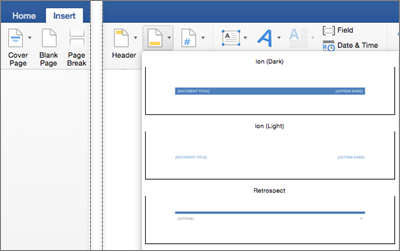

#Ms word for mac 2011 set theme headings windows
That is all there is to using Windows PowerShell to add a header to a document. I open the file, and I see that the header was added. When I run the script, the Word document pops up, and then it closes. Now I need to save my changes, close the Word document, and call it quits: As shown here, I simply give it a string that represents the text I want to insert: To do this, I need to use the InsertAfter method from the Range object. $($alignmentTab::wdRight)Īfter I have inserted my alignment tab, I can finally insert my header text. All I do is call the method, and tell it what kind of alignment tab I want to insert. There is a method from the Range object that permits me to do this. I use this value to specify that I want to insert an alignment tab. So to do this, I need to use the wdRight enumeration from the WdAlignmenttabAlignment type that I added earlier. Now, I need my header to be right-justified on my paper. $header = $($HeaderFooterIndex::wdHeaderFooterFirstPage) In the Windows PowerShell ISE, I can use IntelliSense to retrieve the possible values, and therefore, to avoid having to bounce back and forth on MSDN looking stuff up. This is a static property from the type I loaded earlier in my script. I want the header for the first page, so I use the wdHeaderFooterFirstPage enumeration. I then use the Item method to gain access to a specific header.

To do this, I use the Headers property from the Section object to return a Headers collection. This collection includes the Item method. When I call the Sections property from the Document object, it returns a Sections collection. To gain access to the Section object, I use the Item method to retrieve a specific section from the Sections collection. Keep in mind that the sections begin numbering with 1 as opposed to 0. A document object returns and I store it in a variable named $doc. I am working with my Template document right now, so I specify my path to the template, and I then call the Open method.

To edit a Word document, I need to open it. $alignmentTab = ".WdAlignmentTabAlignment" -as $HeaderFooterIndex = ".WdHeaderFooterIndex" -as To do this, I create two types, which I will use directly in the script: It also facilitates looking stuff up on MSDN. I like to use the standard enumerations because it makes the script more readable. $word = New-Object -comobject word.application After I get everything working, I do not need to make the object visible, and I do that by setting the Visible property to $false. When I am writing a single script, I like to make the Word object visible. It is a COM object, so I also need to specify that. I have to create that object as my entry point for automating Word. The place to begin is with the Word.Application object.
#Ms word for mac 2011 set theme headings how to
The cool thing is that when I know how to automate adding a header, I can customize the header, such as to include the title of the article or some other information that would be helpful. For example, if I had added my script in the static header of the Word document template that I created yesterday, I could avoid having to write that script today. What am I talking about? Well, about the time I am finished with one thing, I remember that there is something else I need to do. One of the things that seems to pile on is using Windows PowerShell to automate Microsoft Word. Why can’t we have a nice snowstorm during the summer when it is over 100 degrees with 98 percent humidity? Oh well. It seems that these sorts of things always pile up-we lose the power, it is cold, there is ice and snow-it all happens at the same time. For the thousands of people who lost their power…well, that was a different story. Although the Scripting Wife and I were a bit worried that the power would go off, it turned out to be a huge non-event-at least for us. It was not really a surprise because the weather service did a good job of warning that it would happen. Microsoft Scripting Guy, Ed Wilson, is here. Summary : Microsoft Scripting Guy, Ed Wilson, talks about using Windows PowerShell to add headers to Microsoft Word documents.


 0 kommentar(er)
0 kommentar(er)
